How To Use Fujifilm Disposable Camera
Photography in the late 1980's became casual and relaxed with the very popular unmarried-use, dispensable picture show camera. It was no longer necessary to behave a heavy, expensive photographic camera around your neck and four rolls of movie in your pocket. You could just stick a small-scale, inexpensive, and lightweight disposable film camera in your pocket and never miss a memorable moment or worry most dropping information technology or getting it wet.
Dispensable cameras are pocket-size, simple cameras designed for both apprentice and professional photographers. After temporarily losing ground to digital cameras and smartphones, disposable cameras are coming dorsum due to a renewed involvement in flick photography and because of their ruggedness, small-scale size, waterproof options, lack of rechargeable battery, and lower price. There are as well still many places that will develop dispensable cameras that are affordable and will return your negatives.
With all the digital cameras and smartphones around, you may wonder why anyone would get back to onetime technology instead of moving forward. Below we will hash out the trend and why people are using disposable cameras.
What Is A Disposable Camera?
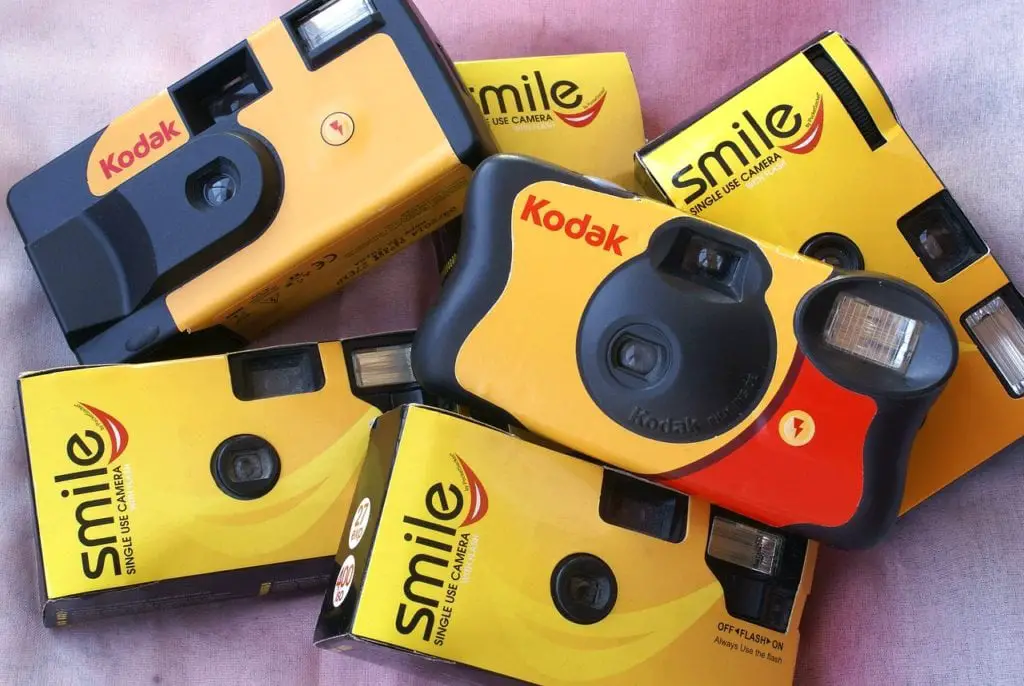
Disposable cameras (also known as single-use or one-time utilize cameras) are small, simple cameras that come up preloaded with either color or black & white film and have no focus or exposure controls other than a congenital-in wink and meant to be used in one case by the photographer. Subsequently all of the 24 – 27 shots are taken the cameras are sent to be processed with the negatives returned forth with prints or digital scans of the images. They have an optical viewfinder and a battery to charge the wink (if they have one). Considering of the inexpensive materials used to build these cameras, they produce images that are bright, high-contrast, with saturated colors, and mostly sharp.
The "dispensable" in disposable camera ways they are made from simple materials like plastic, paper, paper-thin, and metal to make the camera cheaper and not be returned to the photographer later on processing. Since they are really meant to be thrown away by the photographer, they are often chosen Single-Use or One-Fourth dimension utilise cameras, which is more fitting. For those that desire a more sustainable camera just still want the specific disposable or unmarried-use camera await to their images, at that place are reusable cameras bachelor that come preloaded with film or refilled past the consumer to be used over and over like the Ilford Sprite 35-two.
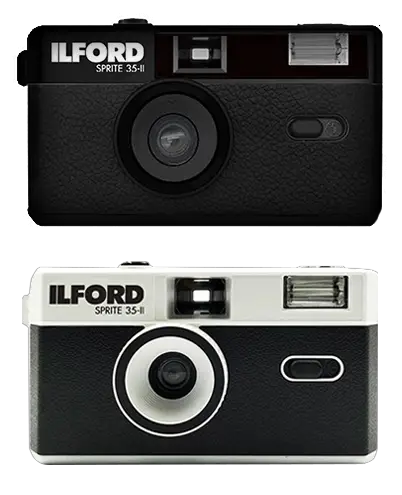
Why Are Disposable Cameras Coming Dorsum?
Disposable or single-use cameras are becoming pop again even though we have the clarity and convenience of digital. In that location are several reasons driving the return of dispensable flick cameras.
- No filter means the photo has an authentic feel
- No preview or delete option means you get what you get
- Express number of exposures makes you choose your images carefully
- The element of surprise adds to the fun of seeing your pictures when you lot receive the prints or digital scans
- Printed pictures can be shared in ways that digital images cannot
Oft, we find that the older way works best, and that is certainly true in the case of disposable or erstwhile use cameras. People are returning to the simple disposable camera to capture their memories because the bright, grainy photograph brings back memories of simpler days earlier we all felt the need to photograph every meal and moment. The scenes we choose to spend our limited number of shots (generally around 24 – 27) with unmarried-utilize cameras accept greater significance because of the scarcity of shots available to us.
With a disposable or single-utilize photographic camera nosotros capture the realness of an authentic moment equally it happens. Information technology simply is what it is. The vulnerability of those moments is what draws us back to using the disposable moving-picture show camera afterward around two decades of presenting perfectly retouched images for the world to see. Finally, nosotros get to come up back to just beingness who we are, non worrying nigh getting the right picture, and enjoying every moment.
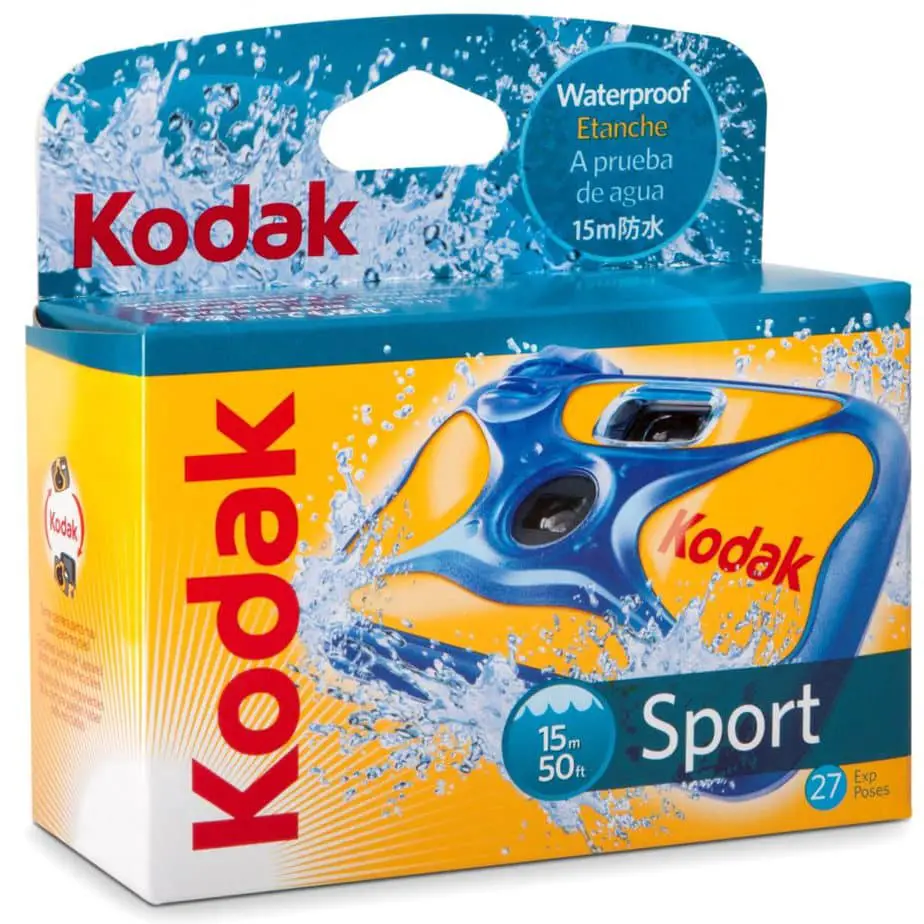
Why Do Disposable Cameras Exist?
Disposable cameras were invented for the general public who wanted to preserve moments without the hassle a complicated process and not having to worry about dropping or losing their expensive camera. Dispensable cameras combined the best traits of cameras into ane small, mostly indestructible package and are:
- Easy to Use
- Inexpensive
- Rugged
- Small and Lightweight
- Lack of rechargeable battery
- Some are waterproof
- No-fuss developing procedure
For example, these are the kinds of cameras nature-lovers would like accept on a hike or have on a mount climb. They have no battery to recharge, tin be waterproof, piece of cake to stick it in your pocket making it inside piece of cake reach when yous desire it, and unfazed by the bumps and falls of the trail.
Who Invented Disposable Cameras?
Kodak was the major US camera manufacturer to begin selling a photographic camera that was easy to use for the full general public in 1888 like to the disposable cameras we know today. The Kodak No. 1 was created by the companies founder George Eastman and sold for $25. The camera was a leather, box camera that came preloaded with roll film that could take 100 images. For $10 the camera could be sent back to Kodak and film negatives would be developed, the images printed on modest sheets of paper, and the camera would be returned with more picture loaded into it.
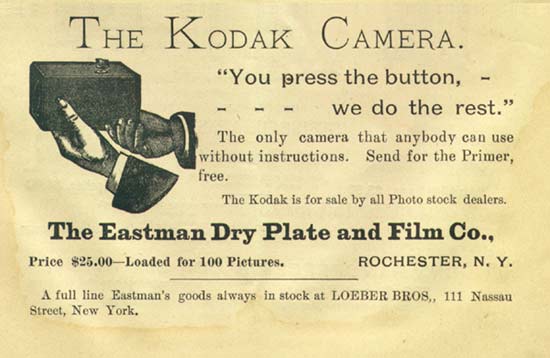
Kodak famously advertised the camera with the slogan "You Press the Push button, We Exercise the Rest". The low price of the camera and how easy it was to use, information technology only had i push button and no other controls other than the viewfinder, made photography bachelor to everyone rather than simply professional person photographers.
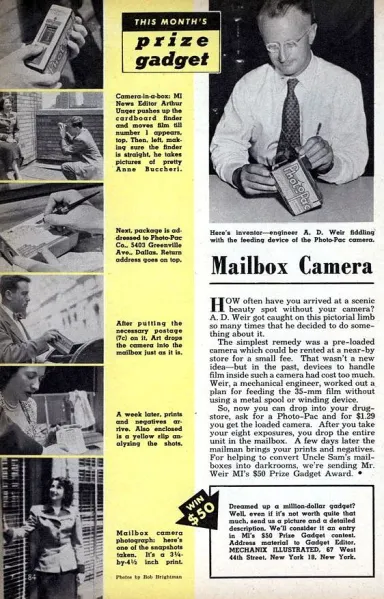
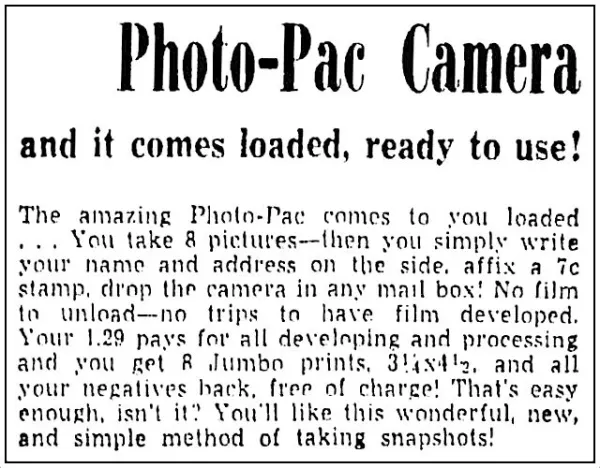
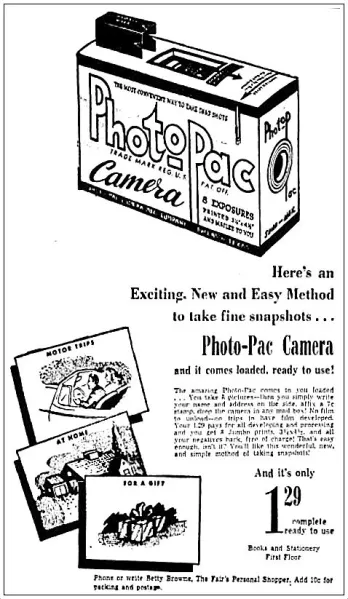
The first truly disposable camera was invented past H. Thou. Stiles in 1949, called the Photograph-Pac, and cost $1.29 for 8 exposures (the modern toll of around $fourteen.36). The user would send the camera dorsum to the company to get the film developed and be sent images dorsum. Although It seems to have been very popular as both a novelty impulse buy and equally a useful production for people who either did not own cameras or who did not want to take their family cameras on trips. The photographic camera probably would have caught on but by 1950 court documents tin can exist constitute that the company faces lawsuits and the cameras could be plant in magazines with deeply discounted.
Seventeen years later on, the French company FEX introduced its version of a disposable photographic camera. The popular disposable cameras of the last century was introduced in 1986, by Fujifilm and by Kodak in 1987 which became available everywhere by 2005.
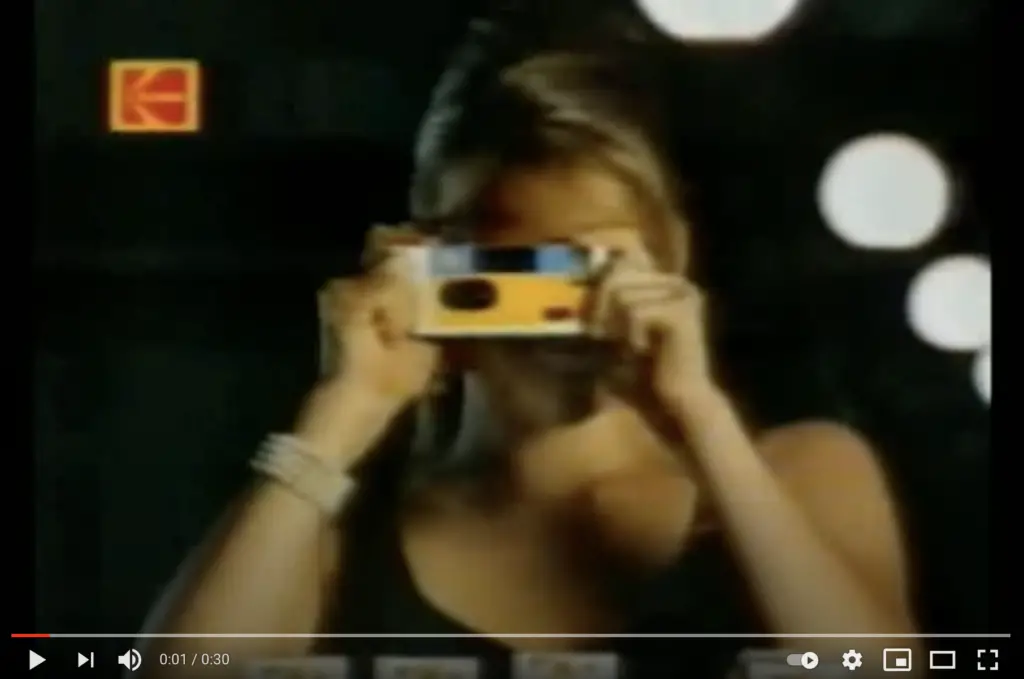
In 2004, the United states was introduced to the disposable digital camera created by a San Francisco-based company called Pure Digital that individual labeled digital dispensable cameras for the CVS pharmacy, Ritz Camera, and Disney for their theme parks. The Pure Digital company would also go on to create and release what would become the Flip video cameras in 2006. The digital cameras sold by CVS had a resolution of 2 MP, included a fully automatic flash, exposure control, and a ten-2nd self-timer simply could only hold 25 images. The cameras cost around $xix for a version with a ane.4 inch LCD screen preview (a new feature over other cameras sold at Walgreens) and delete part and around $nine.99 for a digital camera with merely the delete function. The cameras needed to exist returned to the shop for processing, which included 4×vi inch prints, an index print, and photo CD that could exist read on a the computer for an additional $ix.99.
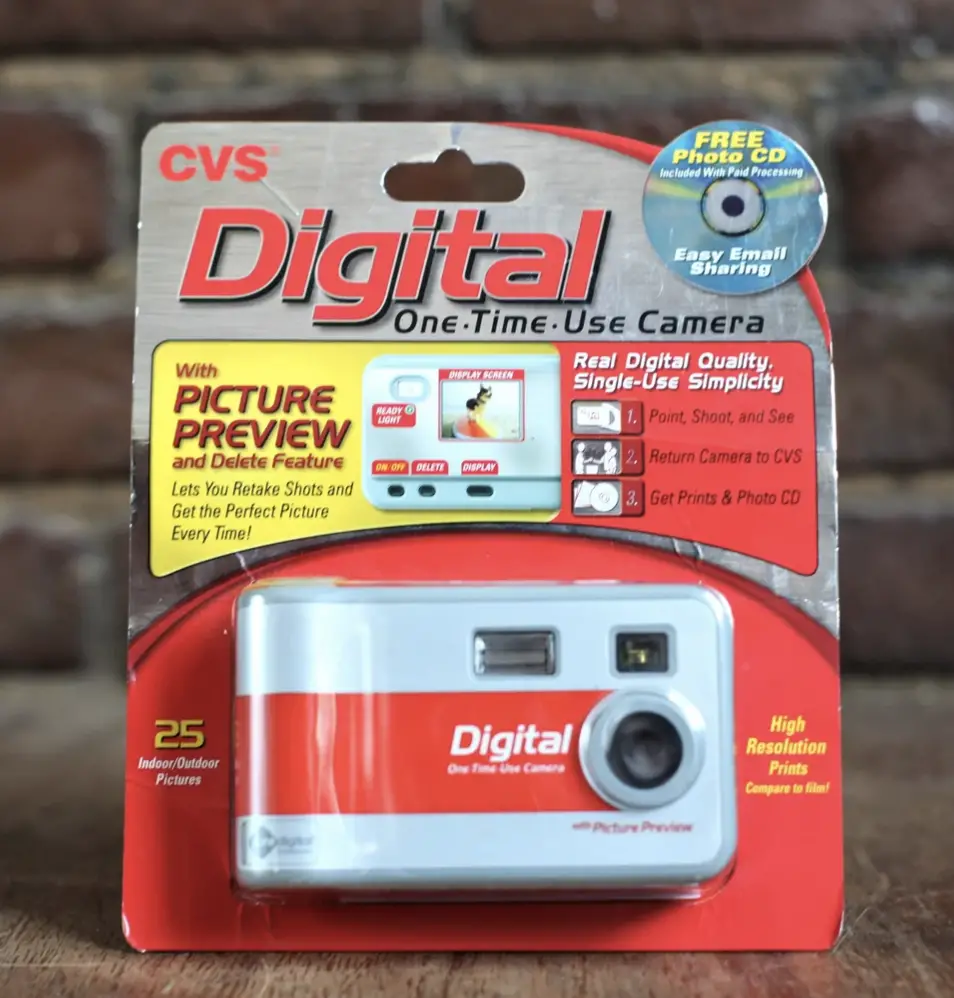
Practice Disposable Cameras Accept Good Pictures?
The quality of picture from a disposable camera varies with the photographic camera and depending on the materials used to produce the camera. For example, well-nigh disposable or single-use cameras accept plastic lenses and a strong wink, which give the characteristic high-dissimilarity, saturated colors, more often than not sharp, and bright images shot with disposable or single-utilize cameras.
While dispensable or unmarried-use cameras won't produce the same quality images as high-stop digital cameras or your smartphone because of their lower quality build materials, bright wink, fixed aperture, fixed shutter speed, and plastic lens, there are higher-end film cameras like Leica or Contax g series cameras that tin can produce images better than digital cameras with more controls.
The secret for getting proficient photos from a disposable photographic camera lies in knowing the cameras limitations. For example, the flash is just skillful between 4 – 10 ft, the camera will only focus on objects 4 ft from the photographic camera while anything closer will be blurry. This also ways anyone standing beyond 10ft from the photographic camera at night won't be lit well the wink on the camera. As well, considering you are not able to change the shutter speed or discontinuity on disposable cameras they needs a lot of light (like outside during a vivid sunny day or using the flash when within) to make great images.



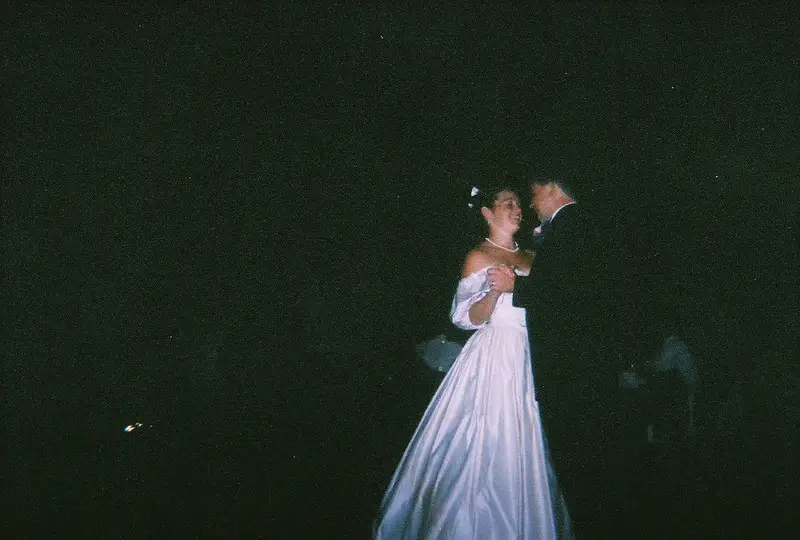
Also, almost all disposable or single-use motion picture cameras use 35mm film, which means the images have enough resolution to be enlarged to 8x10in and in some cases, upwards to eleven×fourteen inches.
All-time Disposable Flick Cameras
Below is a list of the all-time 35mm and waterproof disposable cameras including where to purchase them. if y'all want to know more almost where to purchase disposable cameras and more than about reloadable dispensable cameras, come across this article.
35mm Disposable Cameras:
| Camera Model | Colour or Black and White Motion picture | Price* | Exposures | Wink? |
|---|---|---|---|---|
| Kodak Fun Saver | Color Film (400 ISO) | $thirteen – $15 | 27 | Aye |
| Ilford Single Apply B&Due west Photographic camera HP5+ | Black and White (400 ISO) | $thirteen – $15 | 27 | Aye |
| Fujifilm Quicksnap | Color Motion-picture show (400 ISO) | $eighteen | 27 | Yes |
| Lomography Elementary Use (reloadable) | Color Film (400 ISO) | $32 | 24-36 | Yes W/ Colour Filters |
| Lomography Simple Employ (reloadable) | Black and White (400 ISO) | $22 | 24-36 | Yes |
| Kodak Camera due west/ Flash | Color Film (400 ISO) | $14 | 27 | Yeah |
| Kodak SUC Daylight Disposable Analog Camera | Colour Flick (800 ISO) | $xiv | 39 | No |
Waterproof 35mm Disposable Cameras:
| Waterproof Photographic camera Model | Color or B&Westward | Cost* | Exposures | Flash? |
|---|---|---|---|---|
| FujiFilm Waterproof Quick Snap (two pack) | Color Film (400 ISO) | $35.99 (2-pack) | 27 | No |
| Kodak Waterproof Water & Sport | Colour Film (400 ISO) | $22.99 | 27 | No |
| AgfaPhoto LeBox Bounding main 400 (waterproof) | Colour Motion-picture show (400 ISO) | $xix.95 | 27 | No |
Notation: Virtually disposable cameras have 400 ISO motion picture merely there are a few that accept 800 ISO film loaded into it like the one recommended on the list. A higher ISO means the moving picture is better in lower light but will have more grain in the resulting image.
For more than information virtually unlike disposable cameras available, check out this webpage on TheDarkroom.com.
Do Disposable Cameras Have Batteries?
Only those disposable film cameras with flashes come up with batteries. Some disposable or single-use cameras, similar the Kodak SUC Daylight Disposable Analog Camera and FujiFilm Waterproof Quick Snap cameras does non take a battery since they don't accept a flash and piece of work mechanically. Single-utilise cameras with flashes normally use 1 regular AA or AAA bombardment to charge the wink, which is usually included in the purchase and non meant to be replaced. If you have a reloadable disposable camera, like the Ilford Sprite 35-ii, then y'all will demand to supply ane AAA bombardment for the wink to piece of work.
Do Dispensable Cameras Expire?
While the camera itself does not elapse, the film and bombardment for the flash do expire. Picture show usually expires about ii – 3 years after the manufacture date but may still be good for another five or 6 years if stored away from heat and humidity.
While you can still develop expired film, there is no guarantee that the pictures will have whatsoever degree of quality left especially if the camera wasn't stored properly away from heat, direct sun, and humidity. Color picture show may lose some of its quality after the expiration date and your negatives may be grainier, take less contrast and sharpness, and colour shifts than usual if the moving-picture show has expired because of film deposition and fog. If the camera was stored in estrus, direct lord's day, and in humidity light leaks, color banding, and color shifts may occur.
Picture processing for disposable cameras can exist expensive then y'all don't want to pay for bad photos.
How Long Practice Disposable Cameras Last Undeveloped?
How long undeveloped film volition last depend primarily on how the camera is stored. If information technology is stored where temperatures fluctuate or where humidity tin affect the film, the results will be disappointing. If stored away from straight sunlight, humidity, and rut, the undeveloped cameras will last a year or two after the flick expires.
If you must proceed your undeveloped single-employ camera for a long time, many people recommend storing flick in a refrigerator. If you store your dispensable camera in the refrigerator, make sure to requite information technology time to defrost completely earlier you use it or the moving-picture show will be ruined. This will preserve your film and give information technology the all-time chance of surviving.
Virtually Disposable Cameras Do Not Take Timestamps
Nigh dispensable film cameras do not have a timestamp characteristic. Since the disposable camera is fully mechanical except for the wink, there is no reckoner chip to tell the camera what date or fourth dimension information technology is.
However, this characteristic is available when the motion picture is developed at the lab and usually printed on the back of the print. These can be especially useful when looking through erstwhile pictures and trying to decide when, where, and why they were taken.
Tips for Getting Good Quality Pictures From A Disposable Camera
If used properly, a dispensable camera can produce bright, high-contrast, and interesting photos. As with whatsoever art, one must know the limitations of their tools to get the highest degree of performance from a disposable camera. For all-time results, follow these simple tips:
- Shoot in as much light as possible (well-nigh are made for shooting outside in bright sunlight)
- Make sure your bailiwick is non backlit (or have the master source of calorie-free behind them instead of in front) or they will be in shadow in the printed photo
- Make sure you place the subject 4 – 10 ft from the photographic camera when using the flash (the effective wink range of the photographic camera)
- Brand sure your subject field is at to the lowest degree 4 ft from the camera for them to be in focus and not blurry
- Endeavour dissimilar angles instead of just at eye level (for example, shoot up or downward at your subject)
Exercise Disposable Cameras Piece of work in Depression Low-cal?

Typically, disposable film cameras are not good in low-lite situations without a wink. Using a flash will help in low-light conditions, but it won't light the entire scene. The flash just isn't stiff plenty to provide adequate lighting in settings where natural or artificial light is low or nonexistant. Near one-time utilise cameras suggest a distance of 4 – 10 ft between the camera and the subject area.

Disposable Cameras Don't Piece of work Well in The Night
Disposable cameras don't work well at all in night-time settings because their exposure settings frequently don't change and fix upwards to photo in bright sunlight. Mostly, the wink is your only way of controlling your exposure.
While there is flash on the camera, information technology isn't strong enough to capture a sweeping landscapes or something far away. Your subject needs to be between 4 – 10 ft abroad for the flash to work properly.
Should You Use The Flash on a Disposable Camera?
In most cases, I recommend using the wink on your disposable camera. For example, indoors with the subject at a distance of, or a fiddling past, 4 ft. However, using a wink with a disposable or single-use camera is not always necessary in some environments because a wink will do more damage than good. In brightly lit settings like outside in bright sunlight, the wink is non useful. If your subject is backlit (or standing with the light behind them and so their front is in shadow), a flash is likewise not useful because it isn't strong enough light the entire person. For this to work, virtually single-use cameras suggest between 4 – ten feet.
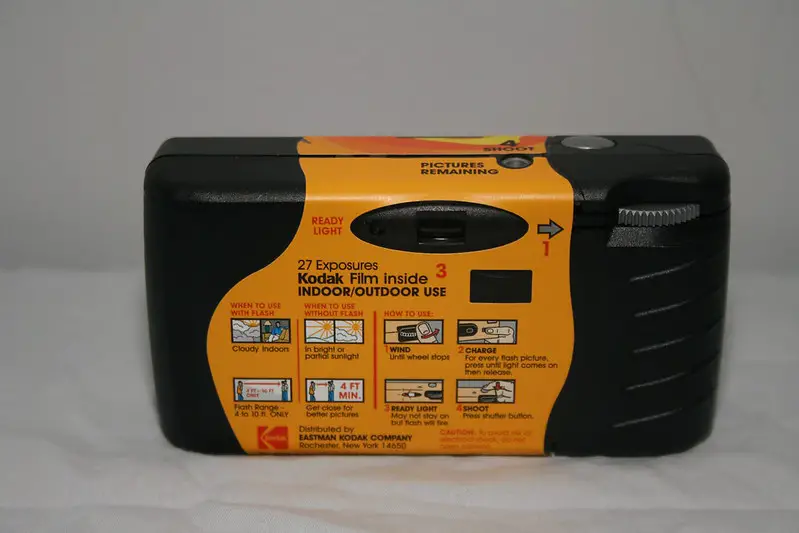
Also, in nearly night settings a flash will not illuminate the field of study properly with either too much or non plenty light. Since the camera doesn't conform the flash corporeality automatically or at all, most cameras advise between 4 – 10 ft between the bailiwick and the camera.

Since there isn't a mode to preview the epitome, you can only gauge at the correct distance or measure out the distance with a ruler. Using a wink discriminately outside will help you shoot images that result in vibrant colors in your prints. Regardless of the setting, having your subject too close will ruin what would have been a good epitome.
If yous decide to not use the wink after it is charged, yous can discharge the flash by pressing the button the front or sliding a button, depending on the model.
How To Clean Your Disposable Camera Lens
Camera lens become dirty from exposure to the being used similar dirt, dust, and the lenses get smudges from greasy fingerprints. Periodically, information technology'south going to exist necessary to clean your lens if y'all want good, clear pictures.
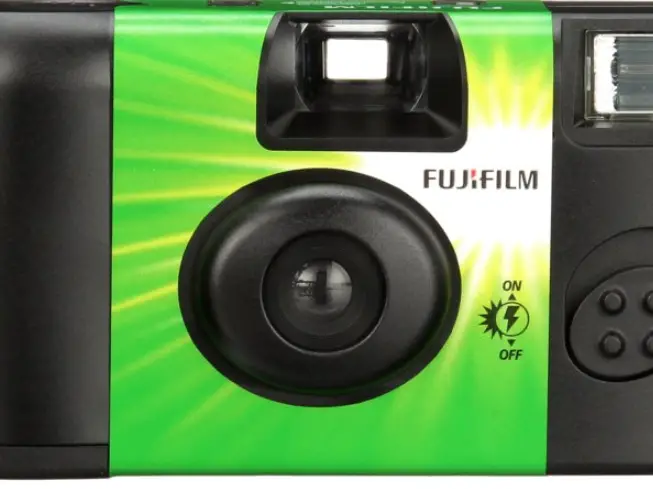
Cleaning a camera lens is not complicated, just information technology does require a soft touch. The cheap, plastic lens can easily exist scratched during cleaning, peculiarly if information technology has been exposed to dust and sand. One thing to proceed in mind when cleaning a disposable or single-use film camera is never to use a t-shirt material to make clean the lens since information technology will scratch the plastic lens of the camera.
Follow these steps to make clean the lens:
- Blow on the lens or use an squeezable blower (like this one) to remove loose clay or dust
- Brush information technology with a soft-bristle brush (similar an unused or clean make-upwardly brush like this one) to remove any grit or dirt on the lens
- Use a lens cleaning liquid for glasses and a q-tip or soft cloth (similar this kit) to become anymore stuck debris. You can also use wipes designed to clean classes and photographic camera lenses similar these.
- Carefully wipe the lens with a soft cloth (like this handy one) to dry the lens and remove smudges and fingerprints
How To Employ Kodak Or Fujifilm Disposable Cameras
To use your Kodak or Fujifilm camera, yous but need to air current the thumbwheel until information technology will non plough anymore to have the showtime picture.
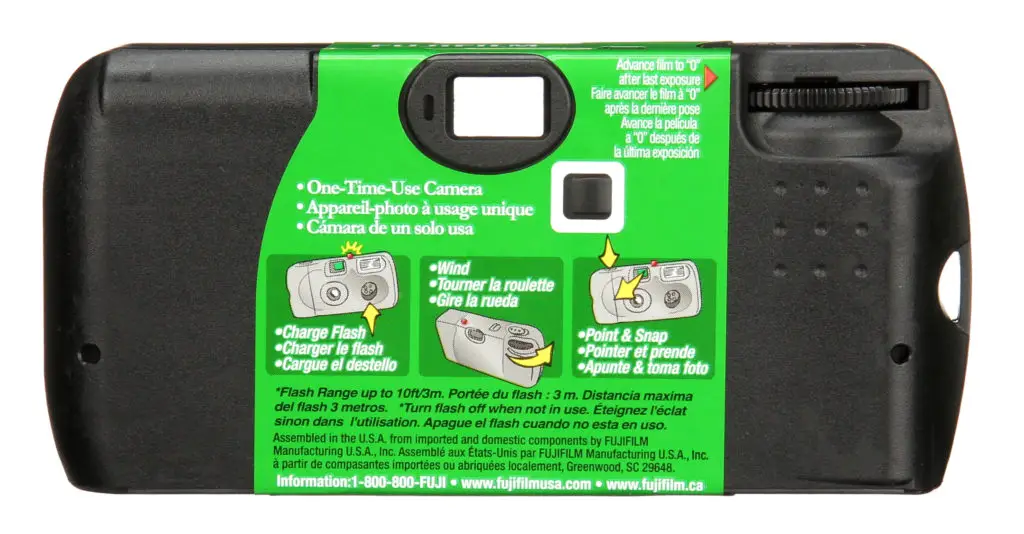
If your photographic camera has a flash, yous volition demand to agree the flash button or slide the button until the low-cal turns crimson to indicate that the capacitor is charged. Then simply signal at your subject, look through the viewfinder until your focus is where you want it and press the button on the top of the photographic camera to brand an exposure.
To apply the wink, you may need to printing a push on the forepart or back of the camera to accuse the wink with power.
Most cameras recommend putting 4 – ten ft between the photographic camera and your subject. Later on taking an paradigm, wind the thumbwheel until the next number appears in the window on the top of the photographic camera to have the next image.
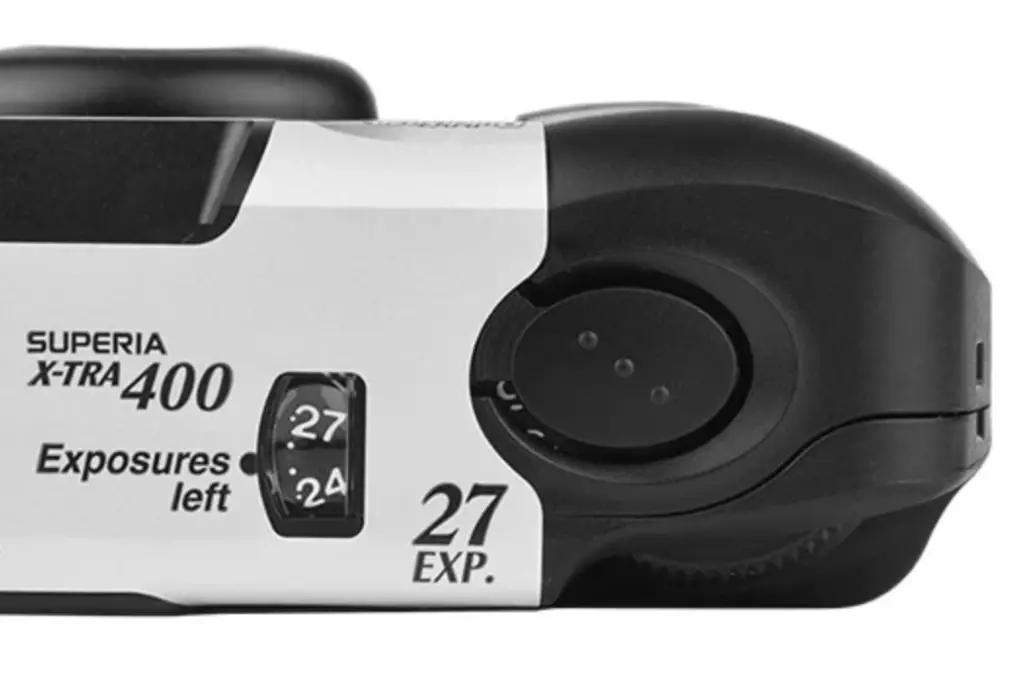
Repeat until all of your frames are exposed. Then ship your photographic camera off to the lab of your choice so they tin can retrieve your images.
Walgreens, CVS, and Walmart all develop disposable cameras simply they don't render your negatives and the scans are just okay. Meet this guide for where to get your disposable cameras adult for well-nigh the same price but with amend scans, negatives returned, and faster turnaround time.
How to Get Pictures From a Disposable Camera on Your Telephone?
Nearly, if non all, of the one-60 minutes photo labs from the 1990'southward are gone, but there are withal labs that can develop your disposable film camera for you lot, return your negatives, and provide you with digital scans of your images so yous can mail them on social media by downloading them on your telephone.
Getting the images you've taken from your dispensable camera to your phone can be a long process. For disposable film cameras, the steps are:
- Turn in or send in the entire photographic camera to the lab or drugstore
- The photo processing lab removes the film and develops the negatives
- The lab scans the negatives
- The lab provides yous with a way to download your images through a link or website Turn in or transport in the entire photographic camera to the lab or drugstore
- The photo processing lab removes the picture show and develops the negatives
- The lab scans the negatives
- The lab provides you with a way to download your images through a link or website and provides you a way to download the images to your phone for sharing on social media or to continue.
- The lab sends dorsum your negatives
The cheapest option to develop your disposable camera is Walmart for $10.96 and comes with a set of 4×6 inch sleeky color prints and CD of digitally scanned negatives. Withal, Walmart won't return your film negatives and the scans come in low resolution. Some other option for evolution is DwaynesPhoto.com, which will develop your disposable camera for $14 and includes meliorate quality scans (or $11 without scans) and they will render your negatives. Nonetheless, the toll doesn't include prints and you have to pay to ship your dispensable photographic camera to them.
For more information well-nigh developing your dispensable camera come across this article about what information technology costs and how long it takes.
How Practice Dispensable Cameras Focus?
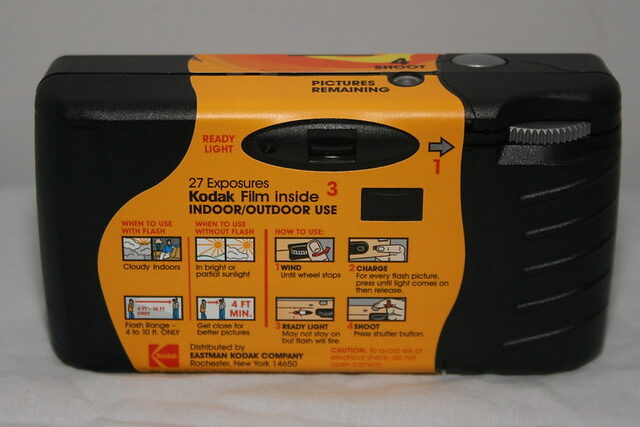
Disposable film cameras accept a pocket-sized, fixed aperture (unremarkably between f8 – f11) that is gear up at a deep depth of field that allows for most everything in the scene to be in focus from a altitude from 4ft from the camera and beyond. This allows you to focus on framing and composing the scene while not having to worry about getting the correct focus.
Can Dispensable Cameras Freeze?
Disposable cameras can still function in sub-zero temperatures with minimal bug. Since a disposable flick camera has little, if any, electronic components at that place is no danger of shorted circuitry from condensation.
To prevent the exterior shell of the camera from freezing and dandy, yous tin can wrap the photographic camera in a freezer bag. After your photographic camera is exposed to extreme common cold, allow it warm up slowly.
A common technique to keep color motion picture from degrading over fourth dimension, especially later expiring, is to store the film in a freezer or fridge. This can too be done with dispensable cameras. Meet this commodity for more information nearly how to store film correctly in the refrigerator or freezer for future use.
Where to Develop Your Disposable Camera Online?
See this guide on where to get your disposable camera developed, how much it costs, and the turnaround fourth dimension. However, the best places in regards to cost, quality, and turnaround time to get your picture show developed online are:
- Dwayne'southward Photo – $14 (including shipping) for colour disposable camera and $xv for a blackness & white disposable photographic camera
- MPIX.com – $nineteen.ninety (including shipping) Keep in mind they only process disposable cameras loaded with color film)
- Process One – $18.97 (including aircraft) for a disposable camera loaded with either colour of black & white picture
Run across this article nigh the all-time price for developing a disposable camera.
Where to Develop Your Disposable Camera Near You?
The best identify probably near you to develop film is Walmart, Walgreens, of CVS since in that location probably is one located close to you. While the development is usually pretty good from these stores, the scans are mediocre at best, low-resolution, and you most probable won't get the negatives dorsum to scan subsequently. For this reason, I recommend mailing your film to a online lab similar DwaynesPhoto.com, MPIX.com, or ProcessOnePhoto.com since they give you better, higher resolution digital scans and return your negatives to y'all.
See this guide about where to develop your disposable camera, how much it costs, the turnaround fourth dimension, and scan quality.
Developing Images Takes A While
Keep in mind that the process of sending your film out for development takes a while. If you utilise a store like Walgreens, CVS, or Walmart on average it takes at least 2 – iii weeks or longer. For instance, my local walmart said it most likely volition take two weeks simply could take upwards to iv weeks.
Online moving-picture show evolution labs differ on their turnaround time (unremarkably is nigh 10 days to 2 weeks) but the deviation is you go higher quality and loftier-resolution scans, digital scans much faster (normally by downloading through dropbox or a similar service) and your negatives are returned.
If you adopt non to wait that long and what to develop your camera past yourself, read this article on how to develop color film at home or this article almost how to develop black & white movie at home. If y'all want to acquire how to develop film in more environmentally friendly means, see this article.
How to Safely Take Your Photographic camera or Movie on A Aeroplane
Taking your disposable camera on holiday is a great idea, but information technology may crusade you lot distress unless you plan well first.
- Try to identify how many times you'll have to laissez passer through airport security
- If possible, obtain a lead-lined purse (like this one from Domke on Amazon.com)
- Proceed your camera and undeveloped moving-picture show in your conduct-on and keep them in a clear, plastic pocketbook
- Ask for camera, new picture show, and unprocessed moving-picture show to exist mitt-checked (including Instant picture)
Exist enlightened that the new airport scanners similar the TSA CT scanners will damage unprocessed film on the offset browse. To proceed your movie from existence ruined, simply put all of your unprocessed or new film in a clear, plastic bag and request a mitt-check. As well, keep in mind but new and unprocessed film will be afflicted, including instant motion-picture show.
Disposable Cameras Can Go Through Some X-Ray Machines, Merely Not The New Ones
Most older X-ray machines found in airports will not cause damage to unexposed picture rated up to ISO 800 unless the movie is subjected to repeated passes through x-rays. Information technology is also not recommended to allow film of higher speeds, like 3200 ISO, to pass through ten-rays.
Yet, be aware that the new airdrome scanners similar the TSA CT scanners and total bag scanners (like those that scan checked baggage) requite off loftier doses of X-Rays and volition damage unprocessed moving-picture show on the first scan. To keep your film from being ruined, merely put all of your unprocessed or new film in a clear, plastic bag and asking a hand-check. Also, go along in heed simply new and unprocessed film volition be affected, including instant picture.
See this website by Kodak for examples of moving picture damaged by ten-ray scanners and what to look for. If you don't desire to risk damage to your film at all, you lot tin place in a lead-lined pouch designed especially for film and cameras.
Annotation: Digital cameras are not affected by x-rays. The electronic components do not collaborate with the x-rays at all, so there is no danger of erased frames or marred images from the radiation.
Best To Take Your Camera in Your Carry-On and Get Paw-checked
Instead of packing your disposable camera in your checked baggage, it's a meliorate idea to pack information technology in your carry-on. Checked luggage is subjected to high doses of radiations from heavy-duty x-rays which pose a greater risk of damage to your film.
The best method to keep your motion picture safety to ask security to manus-bank check your camera and film if possible, then that information technology is not exposed to the x-rays at all. Put your unprocessed dispensable film and photographic camera(southward) into a clear plastic bag (I recommend a sturdy Ziplock gallon pocketbook similar this one on Amazon.com) and ask the attendant for information technology to be checked by hand.
Run across this commodity for more information about how to wing safely with your disposable camera.
Digital Cameras and Smartphones Almost Replaced Disposable Flick Cameras
With the invention of phone cameras, the dispensable motion-picture show camera began to lose its former popularity in the 2000s. As cameras on smartphones became better and ameliorate, it was much more than convenient to shoot photos with your phone than to carry along an extra camera, even if it was only a pocket-sized and lightweight i, and you could meet your images instantly.
Besides, with the smartphone photographic camera the images yous merely shot could be edited and uploaded to the Spider web in minutes, unlike a disposable film camera that has to sent off for development, which could have between an hr – several days.
With long-ish film development process becoming less and less bonny for users and phone cameras falling curt in quality, a new thought was born: the dispensable digital camera.
This photographic camera combines the modest, meaty, lightweight size of a single-use film camera with the convenience of a digital camera to create the perfect solution for those who desire clear, well-nigh instant photos without needing an expensive digital or movie camera. These enjoyed some caste of popularity at first, just never really caught on every bit 1 would have expected. Most consumers felt that they price too much and offered too trivial since most had poor resolution, poor battery life, could just take 24 – 36 images, no delete option or epitome preview (later models that did have information technology cost more), and you yet had to have time to get to a store to get the images off of the camera.
Why Would You Use A Dispensable Camera Today?
A disposable camera would be useful on vacation when you don't want to run a risk dropping, ruining, losing, or your smartphone or expensive digital or film camera stolen.
Hiking or mount-climbing would exist a adept opportunity to utilize a disposable camera because you don't need to recharge a battery, tin be dropped, small and lightweight, they can stand the crude trails, and the clay and dust.
There are also waterproof options to buy like the waterproof single-use disposable film camera (2 pack) from Fujifilm. These are great to use at the beach, lake, or swimming pool to capture images where you don't take to worry most getting your smartphone or digital camera wet and non have to purchase an expensive waterproof case or 1 that is hard to use.
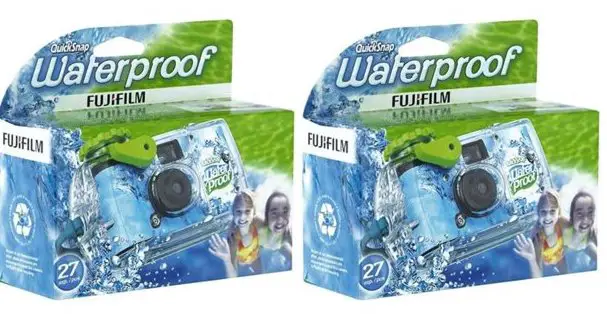
A disposable photographic camera is also great for a young child who shows some photographic involvement and skill but is non yet mature enough to exist entrusted with an expensive professional photographic camera.
Conclusion
Dispensable or single-apply cameras are the perfect film camera to hone your photography skills without wasting money on accessories you don't actually need. If yous're shooting pictures for fun and not money, this photographic camera really is all you demand.
History repeats itself, and in that location seems to always exist an interest in what has come before us in previous generations. So, recently, film manufacturer and movie developers have seen a resurgence of interest in the erstwhile-fashioned disposable film camera virtually of us grew upwards with.
How To Use Fujifilm Disposable Camera,
Source: https://thephotographyprofessor.com/complete-guide-on-disposable-cameras-what-are-they-and-why-are-they-coming-back/
Posted by: ellingtonmorold90.blogspot.com


0 Response to "How To Use Fujifilm Disposable Camera"
Post a Comment